Bachelor in Early Years: Analyzing the Importance of Mathematics
VerifiedAdded on 2023/06/12
|8
|1651
|299
Essay
AI Summary
This essay explores the vital role of mathematics in early years education, emphasizing the development of number sense as a foundational skill for kindergarten children. It discusses the importance of educators focusing on basic mathematical skills to prepare children for more advanced cal...
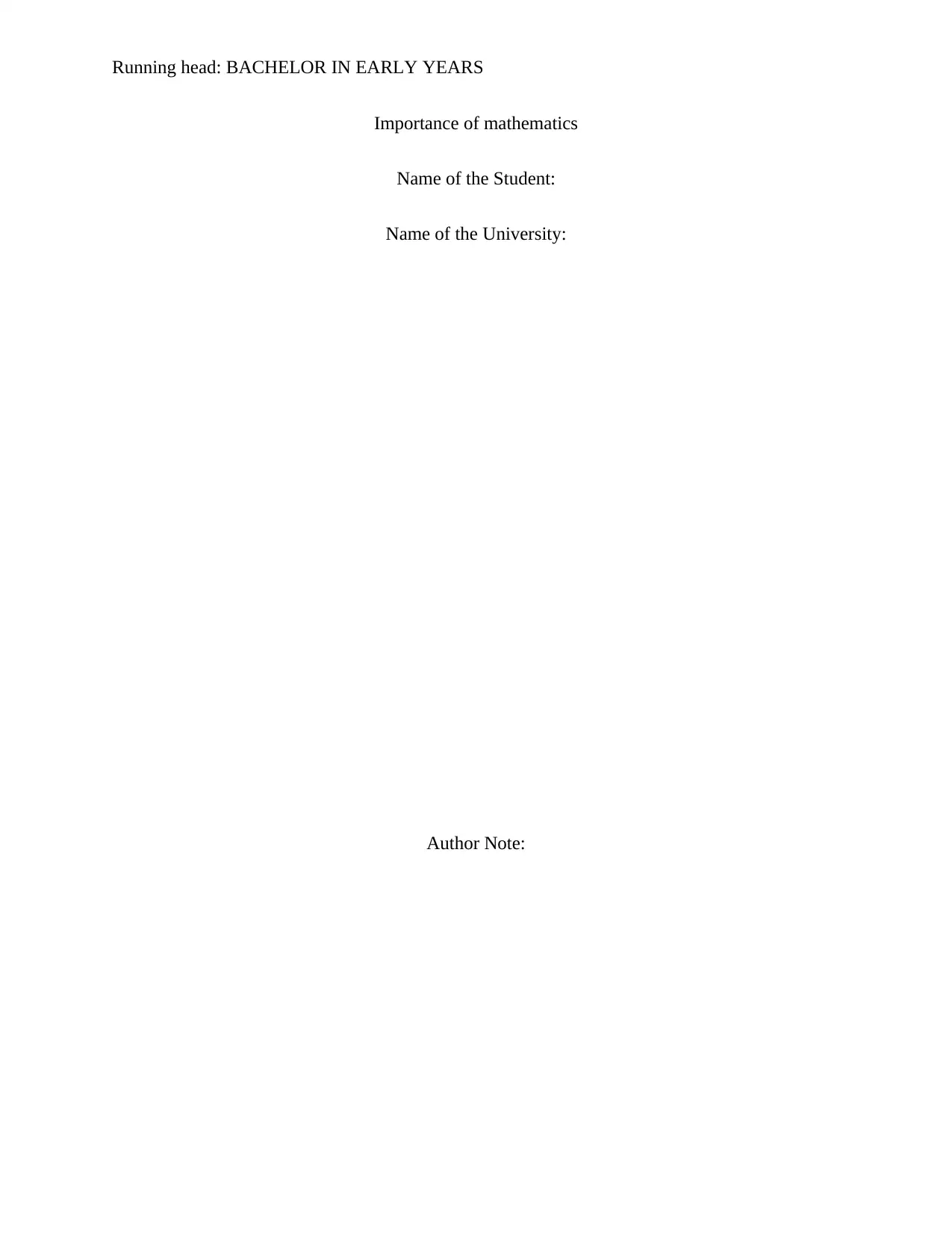
Running head: BACHELOR IN EARLY YEARS
Importance of mathematics
Name of the Student:
Name of the University:
Author Note:
Importance of mathematics
Name of the Student:
Name of the University:
Author Note:
Paraphrase This Document
Need a fresh take? Get an instant paraphrase of this document with our AI Paraphraser
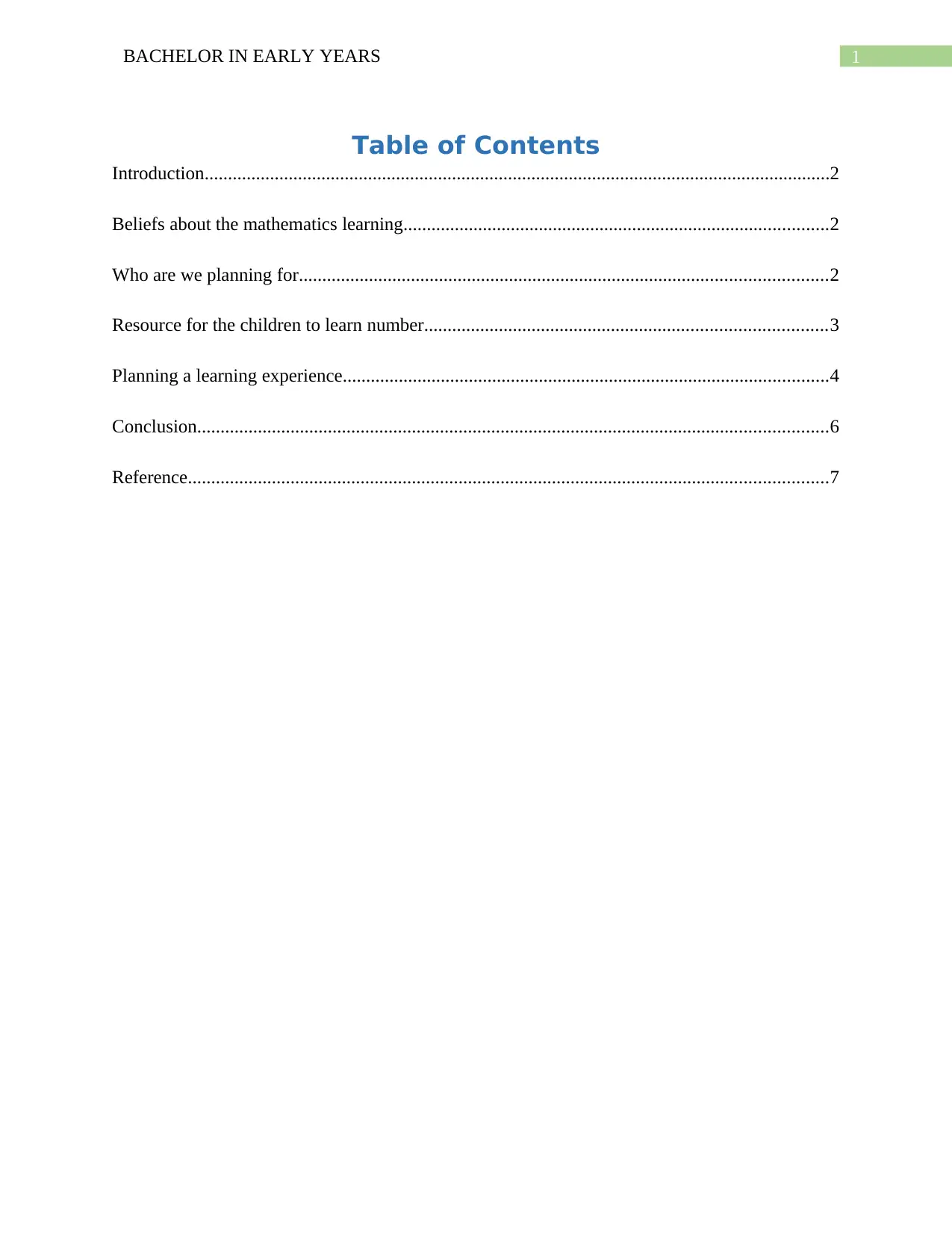
1BACHELOR IN EARLY YEARS
Table of Contents
Introduction......................................................................................................................................2
Beliefs about the mathematics learning...........................................................................................2
Who are we planning for.................................................................................................................2
Resource for the children to learn number......................................................................................3
Planning a learning experience........................................................................................................4
Conclusion.......................................................................................................................................6
Reference.........................................................................................................................................7
Table of Contents
Introduction......................................................................................................................................2
Beliefs about the mathematics learning...........................................................................................2
Who are we planning for.................................................................................................................2
Resource for the children to learn number......................................................................................3
Planning a learning experience........................................................................................................4
Conclusion.......................................................................................................................................6
Reference.........................................................................................................................................7
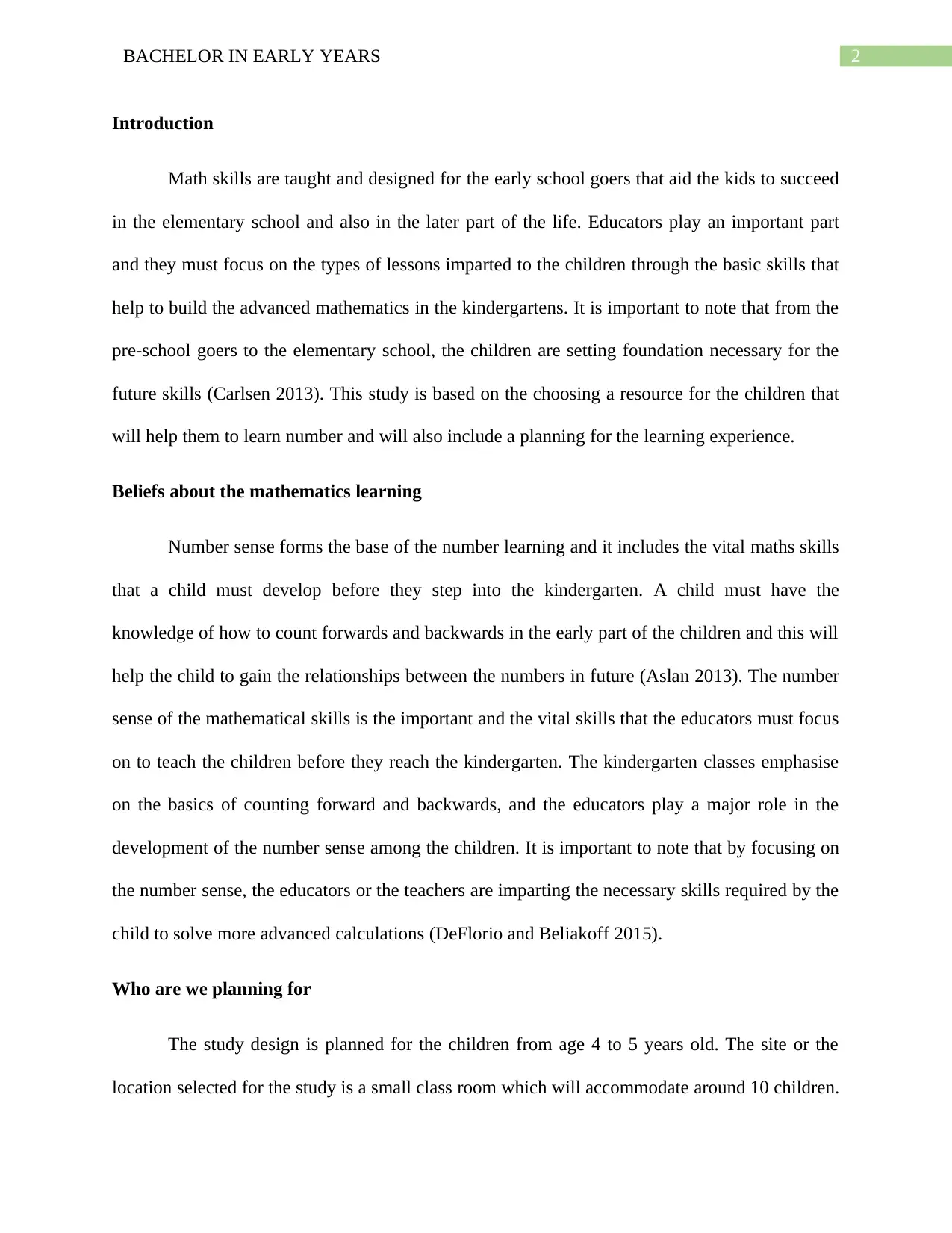
2BACHELOR IN EARLY YEARS
Introduction
Math skills are taught and designed for the early school goers that aid the kids to succeed
in the elementary school and also in the later part of the life. Educators play an important part
and they must focus on the types of lessons imparted to the children through the basic skills that
help to build the advanced mathematics in the kindergartens. It is important to note that from the
pre-school goers to the elementary school, the children are setting foundation necessary for the
future skills (Carlsen 2013). This study is based on the choosing a resource for the children that
will help them to learn number and will also include a planning for the learning experience.
Beliefs about the mathematics learning
Number sense forms the base of the number learning and it includes the vital maths skills
that a child must develop before they step into the kindergarten. A child must have the
knowledge of how to count forwards and backwards in the early part of the children and this will
help the child to gain the relationships between the numbers in future (Aslan 2013). The number
sense of the mathematical skills is the important and the vital skills that the educators must focus
on to teach the children before they reach the kindergarten. The kindergarten classes emphasise
on the basics of counting forward and backwards, and the educators play a major role in the
development of the number sense among the children. It is important to note that by focusing on
the number sense, the educators or the teachers are imparting the necessary skills required by the
child to solve more advanced calculations (DeFlorio and Beliakoff 2015).
Who are we planning for
The study design is planned for the children from age 4 to 5 years old. The site or the
location selected for the study is a small class room which will accommodate around 10 children.
Introduction
Math skills are taught and designed for the early school goers that aid the kids to succeed
in the elementary school and also in the later part of the life. Educators play an important part
and they must focus on the types of lessons imparted to the children through the basic skills that
help to build the advanced mathematics in the kindergartens. It is important to note that from the
pre-school goers to the elementary school, the children are setting foundation necessary for the
future skills (Carlsen 2013). This study is based on the choosing a resource for the children that
will help them to learn number and will also include a planning for the learning experience.
Beliefs about the mathematics learning
Number sense forms the base of the number learning and it includes the vital maths skills
that a child must develop before they step into the kindergarten. A child must have the
knowledge of how to count forwards and backwards in the early part of the children and this will
help the child to gain the relationships between the numbers in future (Aslan 2013). The number
sense of the mathematical skills is the important and the vital skills that the educators must focus
on to teach the children before they reach the kindergarten. The kindergarten classes emphasise
on the basics of counting forward and backwards, and the educators play a major role in the
development of the number sense among the children. It is important to note that by focusing on
the number sense, the educators or the teachers are imparting the necessary skills required by the
child to solve more advanced calculations (DeFlorio and Beliakoff 2015).
Who are we planning for
The study design is planned for the children from age 4 to 5 years old. The site or the
location selected for the study is a small class room which will accommodate around 10 children.
You're viewing a preview
Unlock full access by subscribing today!
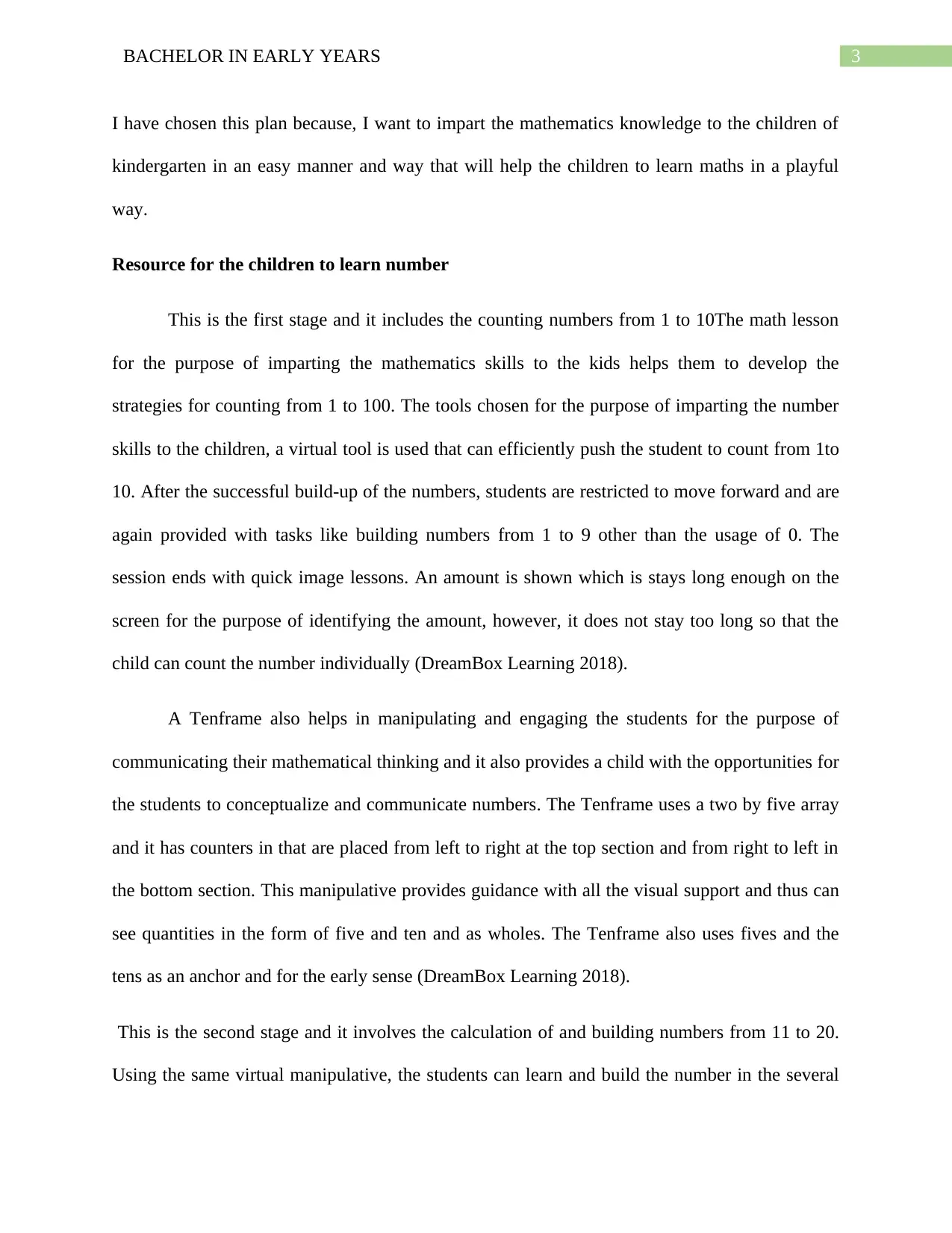
3BACHELOR IN EARLY YEARS
I have chosen this plan because, I want to impart the mathematics knowledge to the children of
kindergarten in an easy manner and way that will help the children to learn maths in a playful
way.
Resource for the children to learn number
This is the first stage and it includes the counting numbers from 1 to 10The math lesson
for the purpose of imparting the mathematics skills to the kids helps them to develop the
strategies for counting from 1 to 100. The tools chosen for the purpose of imparting the number
skills to the children, a virtual tool is used that can efficiently push the student to count from 1to
10. After the successful build-up of the numbers, students are restricted to move forward and are
again provided with tasks like building numbers from 1 to 9 other than the usage of 0. The
session ends with quick image lessons. An amount is shown which is stays long enough on the
screen for the purpose of identifying the amount, however, it does not stay too long so that the
child can count the number individually (DreamBox Learning 2018).
A Tenframe also helps in manipulating and engaging the students for the purpose of
communicating their mathematical thinking and it also provides a child with the opportunities for
the students to conceptualize and communicate numbers. The Tenframe uses a two by five array
and it has counters in that are placed from left to right at the top section and from right to left in
the bottom section. This manipulative provides guidance with all the visual support and thus can
see quantities in the form of five and ten and as wholes. The Tenframe also uses fives and the
tens as an anchor and for the early sense (DreamBox Learning 2018).
This is the second stage and it involves the calculation of and building numbers from 11 to 20.
Using the same virtual manipulative, the students can learn and build the number in the several
I have chosen this plan because, I want to impart the mathematics knowledge to the children of
kindergarten in an easy manner and way that will help the children to learn maths in a playful
way.
Resource for the children to learn number
This is the first stage and it includes the counting numbers from 1 to 10The math lesson
for the purpose of imparting the mathematics skills to the kids helps them to develop the
strategies for counting from 1 to 100. The tools chosen for the purpose of imparting the number
skills to the children, a virtual tool is used that can efficiently push the student to count from 1to
10. After the successful build-up of the numbers, students are restricted to move forward and are
again provided with tasks like building numbers from 1 to 9 other than the usage of 0. The
session ends with quick image lessons. An amount is shown which is stays long enough on the
screen for the purpose of identifying the amount, however, it does not stay too long so that the
child can count the number individually (DreamBox Learning 2018).
A Tenframe also helps in manipulating and engaging the students for the purpose of
communicating their mathematical thinking and it also provides a child with the opportunities for
the students to conceptualize and communicate numbers. The Tenframe uses a two by five array
and it has counters in that are placed from left to right at the top section and from right to left in
the bottom section. This manipulative provides guidance with all the visual support and thus can
see quantities in the form of five and ten and as wholes. The Tenframe also uses fives and the
tens as an anchor and for the early sense (DreamBox Learning 2018).
This is the second stage and it involves the calculation of and building numbers from 11 to 20.
Using the same virtual manipulative, the students can learn and build the number in the several
Paraphrase This Document
Need a fresh take? Get an instant paraphrase of this document with our AI Paraphraser
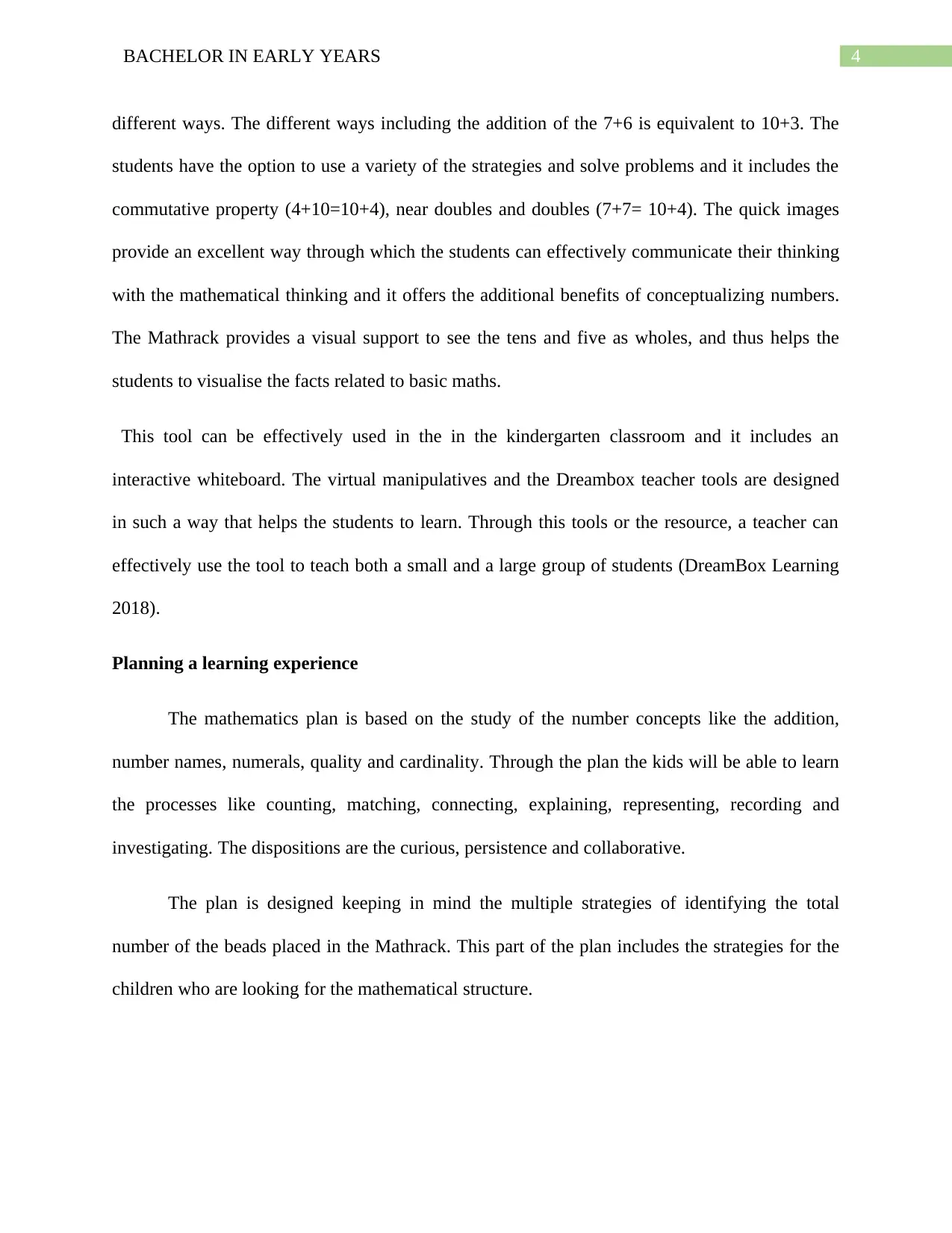
4BACHELOR IN EARLY YEARS
different ways. The different ways including the addition of the 7+6 is equivalent to 10+3. The
students have the option to use a variety of the strategies and solve problems and it includes the
commutative property (4+10=10+4), near doubles and doubles (7+7= 10+4). The quick images
provide an excellent way through which the students can effectively communicate their thinking
with the mathematical thinking and it offers the additional benefits of conceptualizing numbers.
The Mathrack provides a visual support to see the tens and five as wholes, and thus helps the
students to visualise the facts related to basic maths.
This tool can be effectively used in the in the kindergarten classroom and it includes an
interactive whiteboard. The virtual manipulatives and the Dreambox teacher tools are designed
in such a way that helps the students to learn. Through this tools or the resource, a teacher can
effectively use the tool to teach both a small and a large group of students (DreamBox Learning
2018).
Planning a learning experience
The mathematics plan is based on the study of the number concepts like the addition,
number names, numerals, quality and cardinality. Through the plan the kids will be able to learn
the processes like counting, matching, connecting, explaining, representing, recording and
investigating. The dispositions are the curious, persistence and collaborative.
The plan is designed keeping in mind the multiple strategies of identifying the total
number of the beads placed in the Mathrack. This part of the plan includes the strategies for the
children who are looking for the mathematical structure.
different ways. The different ways including the addition of the 7+6 is equivalent to 10+3. The
students have the option to use a variety of the strategies and solve problems and it includes the
commutative property (4+10=10+4), near doubles and doubles (7+7= 10+4). The quick images
provide an excellent way through which the students can effectively communicate their thinking
with the mathematical thinking and it offers the additional benefits of conceptualizing numbers.
The Mathrack provides a visual support to see the tens and five as wholes, and thus helps the
students to visualise the facts related to basic maths.
This tool can be effectively used in the in the kindergarten classroom and it includes an
interactive whiteboard. The virtual manipulatives and the Dreambox teacher tools are designed
in such a way that helps the students to learn. Through this tools or the resource, a teacher can
effectively use the tool to teach both a small and a large group of students (DreamBox Learning
2018).
Planning a learning experience
The mathematics plan is based on the study of the number concepts like the addition,
number names, numerals, quality and cardinality. Through the plan the kids will be able to learn
the processes like counting, matching, connecting, explaining, representing, recording and
investigating. The dispositions are the curious, persistence and collaborative.
The plan is designed keeping in mind the multiple strategies of identifying the total
number of the beads placed in the Mathrack. This part of the plan includes the strategies for the
children who are looking for the mathematical structure.
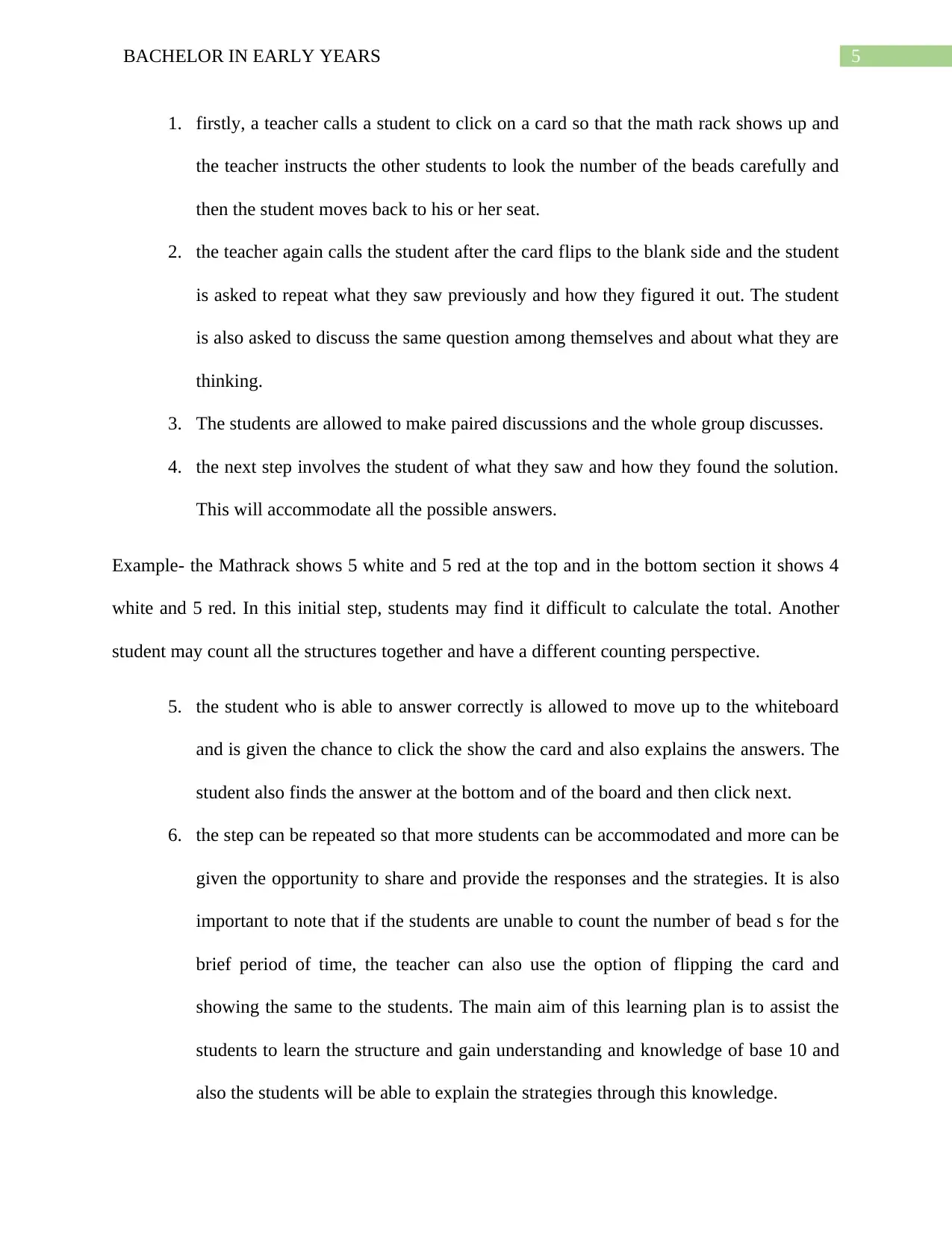
5BACHELOR IN EARLY YEARS
1. firstly, a teacher calls a student to click on a card so that the math rack shows up and
the teacher instructs the other students to look the number of the beads carefully and
then the student moves back to his or her seat.
2. the teacher again calls the student after the card flips to the blank side and the student
is asked to repeat what they saw previously and how they figured it out. The student
is also asked to discuss the same question among themselves and about what they are
thinking.
3. The students are allowed to make paired discussions and the whole group discusses.
4. the next step involves the student of what they saw and how they found the solution.
This will accommodate all the possible answers.
Example- the Mathrack shows 5 white and 5 red at the top and in the bottom section it shows 4
white and 5 red. In this initial step, students may find it difficult to calculate the total. Another
student may count all the structures together and have a different counting perspective.
5. the student who is able to answer correctly is allowed to move up to the whiteboard
and is given the chance to click the show the card and also explains the answers. The
student also finds the answer at the bottom and of the board and then click next.
6. the step can be repeated so that more students can be accommodated and more can be
given the opportunity to share and provide the responses and the strategies. It is also
important to note that if the students are unable to count the number of bead s for the
brief period of time, the teacher can also use the option of flipping the card and
showing the same to the students. The main aim of this learning plan is to assist the
students to learn the structure and gain understanding and knowledge of base 10 and
also the students will be able to explain the strategies through this knowledge.
1. firstly, a teacher calls a student to click on a card so that the math rack shows up and
the teacher instructs the other students to look the number of the beads carefully and
then the student moves back to his or her seat.
2. the teacher again calls the student after the card flips to the blank side and the student
is asked to repeat what they saw previously and how they figured it out. The student
is also asked to discuss the same question among themselves and about what they are
thinking.
3. The students are allowed to make paired discussions and the whole group discusses.
4. the next step involves the student of what they saw and how they found the solution.
This will accommodate all the possible answers.
Example- the Mathrack shows 5 white and 5 red at the top and in the bottom section it shows 4
white and 5 red. In this initial step, students may find it difficult to calculate the total. Another
student may count all the structures together and have a different counting perspective.
5. the student who is able to answer correctly is allowed to move up to the whiteboard
and is given the chance to click the show the card and also explains the answers. The
student also finds the answer at the bottom and of the board and then click next.
6. the step can be repeated so that more students can be accommodated and more can be
given the opportunity to share and provide the responses and the strategies. It is also
important to note that if the students are unable to count the number of bead s for the
brief period of time, the teacher can also use the option of flipping the card and
showing the same to the students. The main aim of this learning plan is to assist the
students to learn the structure and gain understanding and knowledge of base 10 and
also the students will be able to explain the strategies through this knowledge.
You're viewing a preview
Unlock full access by subscribing today!
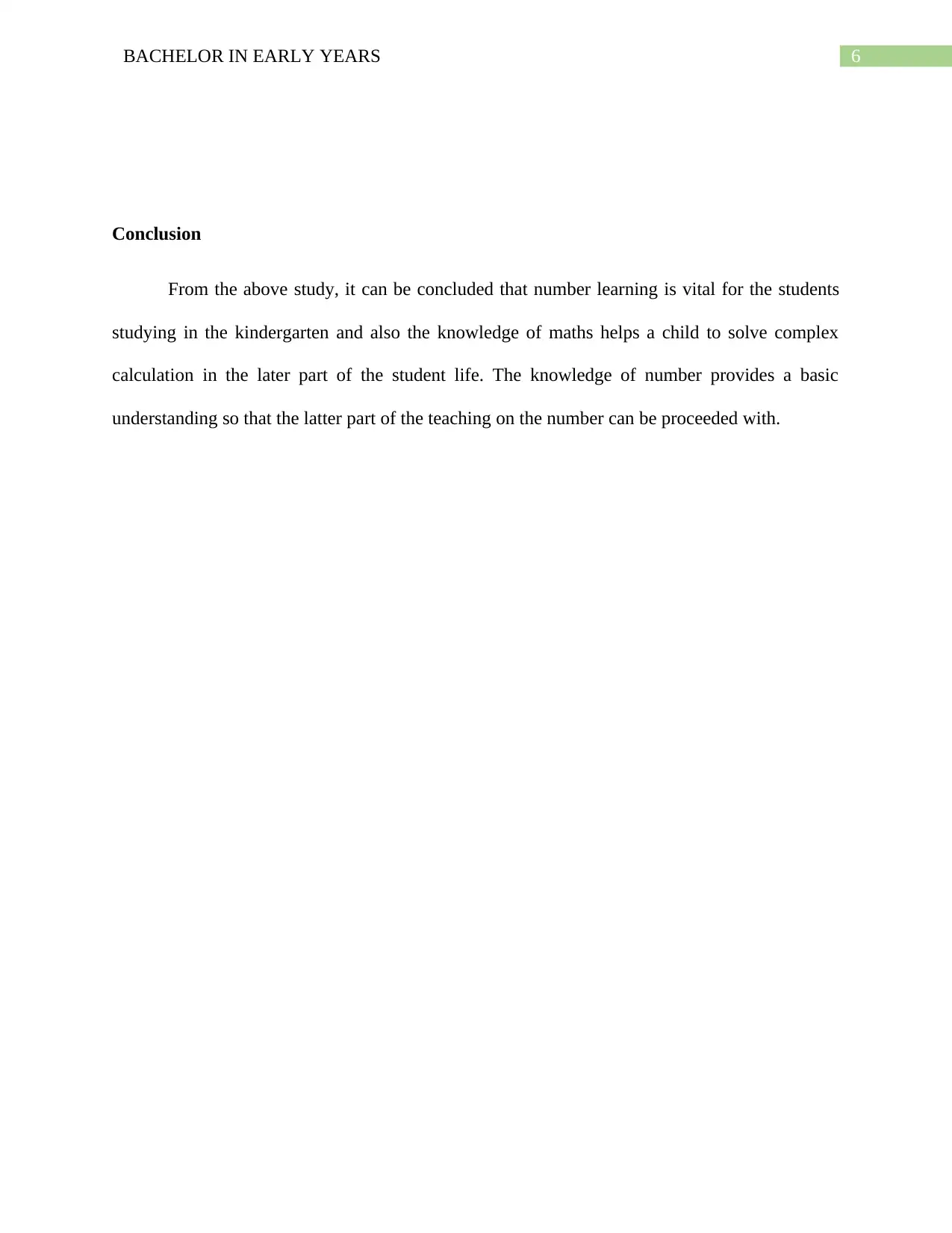
6BACHELOR IN EARLY YEARS
Conclusion
From the above study, it can be concluded that number learning is vital for the students
studying in the kindergarten and also the knowledge of maths helps a child to solve complex
calculation in the later part of the student life. The knowledge of number provides a basic
understanding so that the latter part of the teaching on the number can be proceeded with.
Conclusion
From the above study, it can be concluded that number learning is vital for the students
studying in the kindergarten and also the knowledge of maths helps a child to solve complex
calculation in the later part of the student life. The knowledge of number provides a basic
understanding so that the latter part of the teaching on the number can be proceeded with.
Paraphrase This Document
Need a fresh take? Get an instant paraphrase of this document with our AI Paraphraser
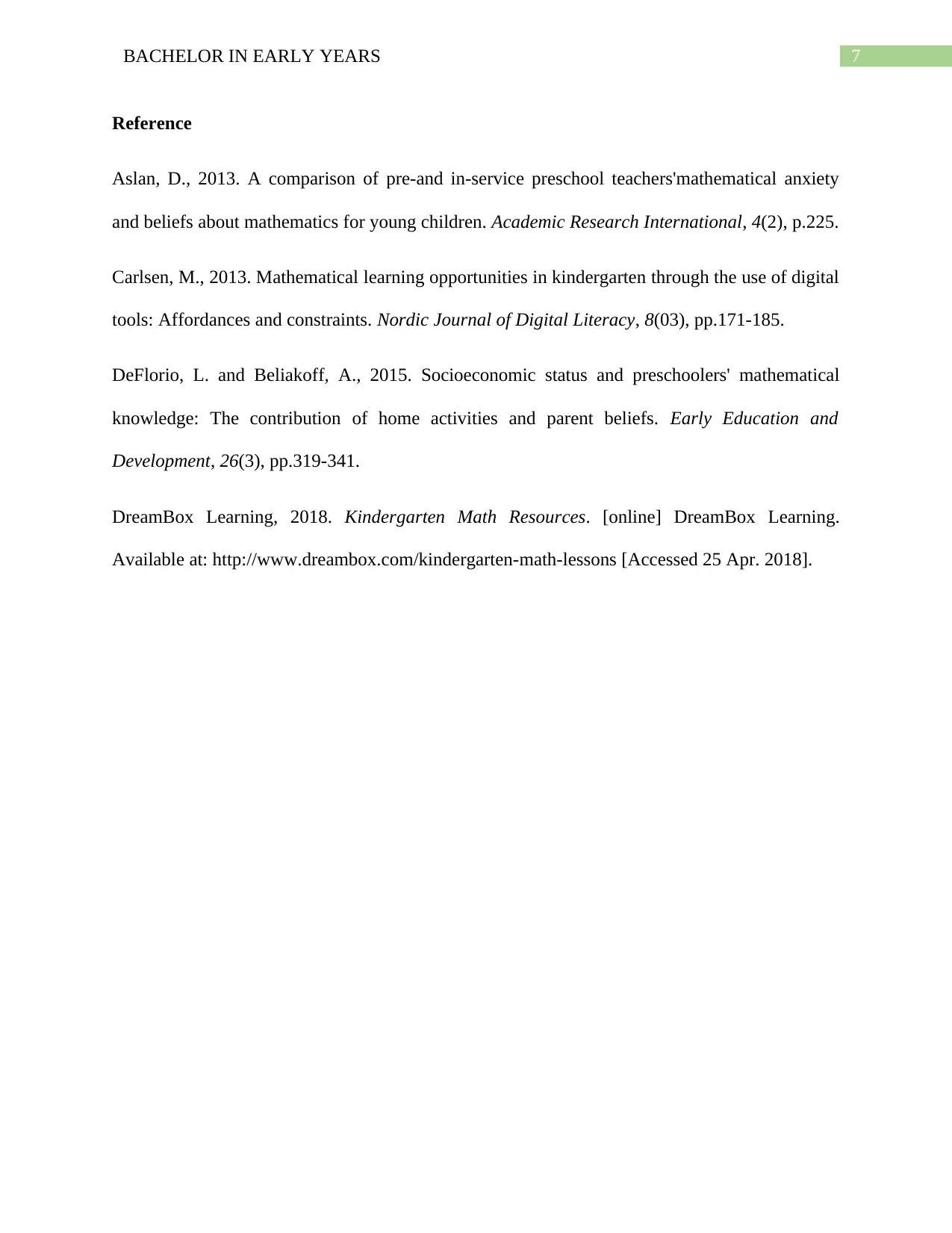
7BACHELOR IN EARLY YEARS
Reference
Aslan, D., 2013. A comparison of pre-and in-service preschool teachers'mathematical anxiety
and beliefs about mathematics for young children. Academic Research International, 4(2), p.225.
Carlsen, M., 2013. Mathematical learning opportunities in kindergarten through the use of digital
tools: Affordances and constraints. Nordic Journal of Digital Literacy, 8(03), pp.171-185.
DeFlorio, L. and Beliakoff, A., 2015. Socioeconomic status and preschoolers' mathematical
knowledge: The contribution of home activities and parent beliefs. Early Education and
Development, 26(3), pp.319-341.
DreamBox Learning, 2018. Kindergarten Math Resources. [online] DreamBox Learning.
Available at: http://www.dreambox.com/kindergarten-math-lessons [Accessed 25 Apr. 2018].
Reference
Aslan, D., 2013. A comparison of pre-and in-service preschool teachers'mathematical anxiety
and beliefs about mathematics for young children. Academic Research International, 4(2), p.225.
Carlsen, M., 2013. Mathematical learning opportunities in kindergarten through the use of digital
tools: Affordances and constraints. Nordic Journal of Digital Literacy, 8(03), pp.171-185.
DeFlorio, L. and Beliakoff, A., 2015. Socioeconomic status and preschoolers' mathematical
knowledge: The contribution of home activities and parent beliefs. Early Education and
Development, 26(3), pp.319-341.
DreamBox Learning, 2018. Kindergarten Math Resources. [online] DreamBox Learning.
Available at: http://www.dreambox.com/kindergarten-math-lessons [Accessed 25 Apr. 2018].
1 out of 8
Related Documents
Your All-in-One AI-Powered Toolkit for Academic Success.
+13062052269
info@desklib.com
Available 24*7 on WhatsApp / Email
![[object Object]](/_next/static/media/star-bottom.7253800d.svg)
Unlock your academic potential
© 2024 | Zucol Services PVT LTD | All rights reserved.




